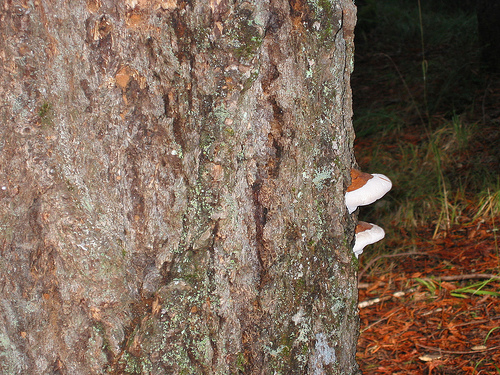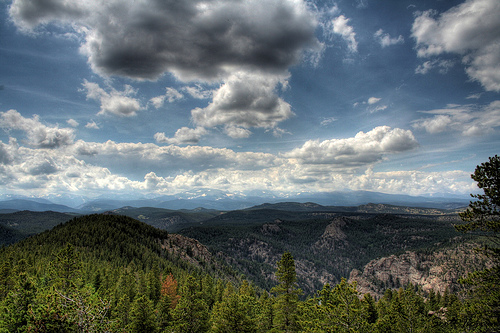Habitat
Even though it may appear that Coast Douglas Firs only inhibit a small area of land, they are in fact able to sustain a wide variety of climates. They are able to live in the meritime climate of the Pacific Northwest as well as the mild continental climate of the Rocky Mountains. Their ideal habitat conditions however, consist of mild, wet winters and cool, somewhat dry summers, a long frost-free season, temperatures reaching highs of 81 degrees Fahrenheit and lows of around 28 degrees Fahrenheit. Large amounts of precipitation are necessary (locations range from 34-134 inches annually) and little snowfall (locations range from 0-24 inches annually). The ideal conditions of the Coast Douglas Fir have been compared to those of the different Spruce species. They prefer soil that is moist, and slightly acidic, and grow best in areas where they receive full sunlight. Some of the factors that result in an unsuitable climate for the Coast Douglas Fir are: high seasonal winds, heavy and wet snowfalls, inappropriate temperatures (too warm or too cold), inadequate amounts of precipitation, or soil that is dry, poorly drained or compacted. Therefore the Coast Douglas Fir fits into its ecological niche based on the temperature, amount of sunlight, amount of precipitation, quality of the soil and the impact of the winds that are necessary for its survival.
Species Interactions
The Coast Douglas Fir holds relationships with thousands of
fungi. Some of the fungi result in mycorrhizal relationships in
which the tree benefits from the fungi's contribution to the
soil, making it more fertile. This results in greater plant
growth and reproduction. The Coast Douglas Fir also plays host
to hundreds of species of fungi. Most of these relationships are
commensal meaning the fungi benefits from living off of the
tree, but the tree is neither harmed nor helped through the
interaction. Some species, however, do cause harm to the Coast
Douglas Fir. Species of Pythium, Rhizodonia,
Phytophthora,
Fuscarium, and Botrytis are re Because the Coast Douglas Fir is phototrophic and makes its
own food, it resides at the bottom of the food web making it an
essential part of the web itslef. The Coast Douglas Fir also
benefits humans in a number of ways. Through photosynthesis it
gives off oxygen which is needed in breathing, an essential task
for humans. It also plays a large role in the lumber and logging
industries. sponsible for the destruction of
seedlings. Some other results of this fungi include weakening of
the tree to the point in which it cannot support itself and
falls over, or even death. One of the most dangerous fungi to
the Coast Douglas Fir in the Red Ring Rot which infects the tree
via knots or scars in the wood. Other forms of heart rot that
infect the trees are Formitopsis officinalis, F. cajanderi, and
Phaeolus schweinitzii. The younger trees are more susceptible to
needle diseases brought on by Rhabdocline pseudotsugae, or stem
diseases caused by Arceuthobium douglasii. Many insects are
responsible for infecting the Coast Douglas Fir seeds and cones
including: Douglas Fir Seed Chalcid, Douglas Fir Cone Moth,
Douglas Fir Cone Worm, Douglas Fir Cone Gallmidge, and Douglas
Fir Cone Scale Midge. The seed count may drop based on
consumption of the seeds by animals such as: deer mice,
chipmunks, shrews, and birds. Animals such as hares,
rabbits,
beavers, gophers, deer and elk injure the saplings and seedlings
by eating them.
sponsible for the destruction of
seedlings. Some other results of this fungi include weakening of
the tree to the point in which it cannot support itself and
falls over, or even death. One of the most dangerous fungi to
the Coast Douglas Fir in the Red Ring Rot which infects the tree
via knots or scars in the wood. Other forms of heart rot that
infect the trees are Formitopsis officinalis, F. cajanderi, and
Phaeolus schweinitzii. The younger trees are more susceptible to
needle diseases brought on by Rhabdocline pseudotsugae, or stem
diseases caused by Arceuthobium douglasii. Many insects are
responsible for infecting the Coast Douglas Fir seeds and cones
including: Douglas Fir Seed Chalcid, Douglas Fir Cone Moth,
Douglas Fir Cone Worm, Douglas Fir Cone Gallmidge, and Douglas
Fir Cone Scale Midge. The seed count may drop based on
consumption of the seeds by animals such as: deer mice,
chipmunks, shrews, and birds. Animals such as hares,
rabbits,
beavers, gophers, deer and elk injure the saplings and seedlings
by eating them.
Now that you know about the growing conditions of the Coast Douglas Fir lets find out how it has adapted to this kind of environment. Check out the Adaptations page to find out!
This page was created by Morgan Cook
Contact me at:
cook.morg@students.uwlax.edu
